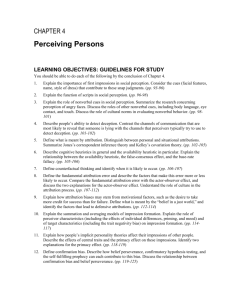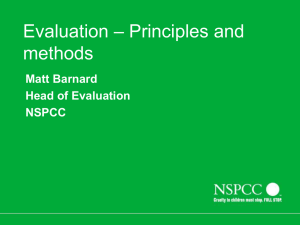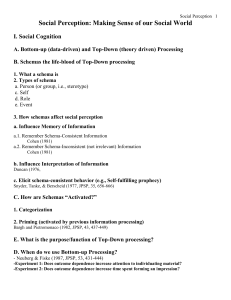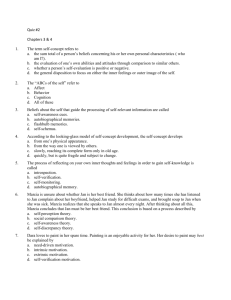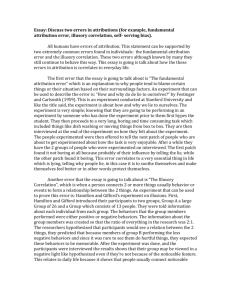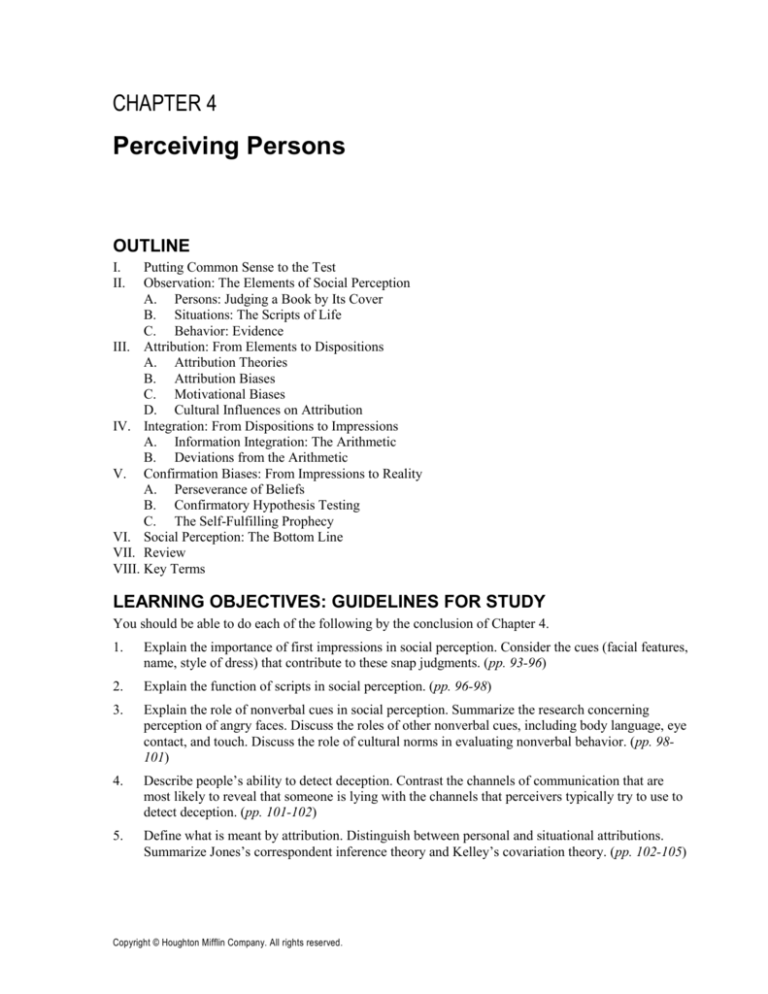
CHAPTER 4
Perceiving Persons
OUTLINE
I.
II.
Putting Common Sense to the Test
Observation: The Elements of Social Perception
A. Persons: Judging a Book by Its Cover
B. Situations: The Scripts of Life
C. Behavior: Evidence
III. Attribution: From Elements to Dispositions
A. Attribution Theories
B. Attribution Biases
C. Motivational Biases
D. Cultural Influences on Attribution
IV. Integration: From Dispositions to Impressions
A. Information Integration: The Arithmetic
B. Deviations from the Arithmetic
V. Confirmation Biases: From Impressions to Reality
A. Perseverance of Beliefs
B. Confirmatory Hypothesis Testing
C. The Self-Fulfilling Prophecy
VI. Social Perception: The Bottom Line
VII. Review
VIII. Key Terms
LEARNING OBJECTIVES: GUIDELINES FOR STUDY
You should be able to do each of the following by the conclusion of Chapter 4.
1.
Explain the importance of first impressions in social perception. Consider the cues (facial features,
name, style of dress) that contribute to these snap judgments. (pp. 93-96)
2.
Explain the function of scripts in social perception. (pp. 96-98)
3.
Explain the role of nonverbal cues in social perception. Summarize the research concerning
perception of angry faces. Discuss the roles of other nonverbal cues, including body language, eye
contact, and touch. Discuss the role of cultural norms in evaluating nonverbal behavior. (pp. 98101)
4.
Describe people’s ability to detect deception. Contrast the channels of communication that are
most likely to reveal that someone is lying with the channels that perceivers typically try to use to
detect deception. (pp. 101-102)
5.
Define what is meant by attribution. Distinguish between personal and situational attributions.
Summarize Jones’s correspondent inference theory and Kelley’s covariation theory. (pp. 102-105)
Copyright © Houghton Mifflin Company. All rights reserved.
44
Chapter 4: Perceiving Persons
6.
Describe cognitive heuristics in general and the availability heuristic in particular. Explain the
relationship between the availability heuristic, the false-consensus effect, and the base-rate
fallacy. (pp. 105-106)
7.
Define counterfactual thinking and identify when it is likely to occur. (pp. 106-107)
8.
Define the fundamental attribution error and describe the factors that make this error more or less
likely to occur. Compare the fundamental attribution error with the actor-observer effect, and
discuss the two explanations for the actor-observer effect. Understand the role of culture in the
attribution process. (pp. 107-112)
9.
Explain how attribution biases may stem from motivational factors, such as the desire to take
more credit for success than for failure. Define what is meant by the “belief in a just world,” and
identify the factors that lead to defensive attributions. (pp. 112-114)
10. Explain the summation and averaging models of impression formation. Explain the role of
perceiver characteristics (including the effects of individual differences, priming, and mood) and
of target characteristics (including the trait negativity bias) on impression formation. (pp. 114117)
11. Explain how people’s implicit personality theories affect their impressions of other people.
Describe the effects of central traits and the primacy effect on these impressions. Identify two
explanations for the primacy effect. (pp. 118-119)
12. Define confirmation bias. Describe how belief perseverance, confirmatory hypothesis testing, and
the self-fulfilling prophecy can each contribute to this bias. Discuss the relationship between
confirmation bias and belief perseverance. (pp. 119-125)
13. Describe generally how people fare as social perceivers, listing reasons for being both optimistic
and pessimistic regarding people’s competence as social perceivers. (pp. 125-127)
MAJOR CONCEPTS: THE BIG PICTURE
Below are four basic issues or principles that organize Chapter 4. You should know these issues and
principles well.
1.
To understand other people’s emotions, motives, and personal dispositions, social perceivers rely
on indirect clues. These indirect clues—the elements of social perception—include information
about persons, situations, and behavior. People’s perceptions of others are influenced by others’
physical appearance, by preconceptions about various types of situations, and by nonverbal
communication.
2.
People try to understand each other by attributing the causes of their behavior to personal factors
or situational factors. Although these attributions often are consistent with the logic represented in
theories of the attribution process, there are several ways in which people’s attributions often
depart from the logic of these theories, resulting in attribution biases.
3.
Perceivers combine different pieces of information about a person to form a coherent overall
impression. The integration of this information depends in part on characteristics of the perceiver,
such as the perceiver’s sensitivity to particular information, and in part on characteristics of the
target, such as the presence or absence of particular types of traits.
4.
Once an impression is formed, people become less likely to change their minds when confronted
with nonsupportive evidence. Rather, they tend to interpret, seek, and even create information in
ways that confirm their existing beliefs.
Copyright © Houghton Mifflin Company. All rights reserved.
Chapter 4: Perceiving Persons
45
KEY TERM EXERCISE: THE CONCEPTS YOU SHOULD KNOW
Below are all of the key terms that appear in boldface in Chapter 4. To help you better understand these
concepts, rather than just memorize them, write a definition for each term in your own words. After
doing so, look at the next section where you’ll find a list of definitions from the textbook for each of the
key terms presented in random order. For each of your definitions, find the corresponding textbook
definition. Note how your definitions compare with those from the textbook.
Key Terms
1.
base-rate fallacy
2.
central traits
3.
situational attribution
4.
belief in a just world
5.
primacy effect
6.
false-consensus effect
7.
social perception
8.
correspondent inference theory
9.
information integration theory
10. availability heuristic
11. personal attribution
12. implicit personality theory
13. covariation principle
14. fundamental attribution error
15. confirmation bias
16. impression formation
17. actor-observer effect
18. nonverbal behavior
19. counterfactual thinking
20. priming
21. self-fulfilling prophecy
22. attribution theory
23. belief perseverance
24. need for closure
Textbook Definitions
a.
A general term for the processes by which people come to understand one another.
b.
A tendency to estimate the likelihood that an event will occur by how easily instances of it
come to mind.
Copyright © Houghton Mifflin Company. All rights reserved.
46
Chapter 4: Perceiving Persons
c.
Behavior that reveals a person’s feelings through facial expressions, body language, and
vocal cues.
d.
A group of theories that describe how people explain the causes of behavior.
e.
Attribution to internal characteristics of an actor, such as ability, personality, mood, or
effort.
f.
Attribution to factors external to an actor, such as the task, other people, luck.
g.
A theory holding that we make inferences about a person when his or her actions are freely
chosen, are unexpected, and result in a small number of desirable effects.
h.
A principle of attribution theory holding that people attribute behavior to factors that are
present when a behavior occurs and absent when it does not.
i.
The tendency to focus on the role of personal causes and underestimate the impact of
situations on other people’s behavior.
j.
The tendency to attribute our own behavior to situational causes and the behavior of others
to personal factors.
k.
A tendency to imagine alternative events or outcomes that might have occurred but did not.
l.
The tendency for people to overestimate the extent to which others share their opinions,
attributes, and behavior.
m.
The finding that people are relatively insensitive to consensus information presented in the
form of numerical base rates.
n.
The belief that individuals get what they deserve in life, an orientation that leads people to
disparage victims.
o.
The process of integrating information about a person to form a coherent impression.
p.
The theory that impressions are based on (1) perceiver dispositions and (2) a weighted
average of a target person’s traits.
q.
The tendency for recently used words or ideas to come to mind easily and influence the
interpretation of new information.
r.
A network of assumptions people make about the relationships among traits and behaviors.
s.
Traits that exert a powerful influence on overall impressions.
t.
The tendency for information presented early in a sequence to have more impact on
impressions than information presented later.
u.
A desire to reduce cognitive uncertainty, which heightens the importance of first
impressions.
v.
The tendency to seek, interpret, and create information that verifies existing beliefs.
w.
The tendency to maintain beliefs even after they have been discredited.
x.
The process by which one’s expectations about a person eventually lead that person to
behave in ways that confirm those expectations.
Copyright © Houghton Mifflin Company. All rights reserved.
Chapter 4: Perceiving Persons
ANSWERS FOR KEY TERM EXERCISE
Answers for the key terms exercise are listed below.
1.
m
2.
s
3.
f
4.
n
5.
t
6.
l
7.
a
8.
g
9.
p
10. b
11. e
12. r
13. h
14. i
15. v
16. o
17. j
18. c
19. k
20. q
21. x
22. d
23. w
24. u
Copyright © Houghton Mifflin Company. All rights reserved.
47
48
Chapter 4: Perceiving Persons
PRACTICE QUIZ: TEST YOUR KNOWLEDGE OF THE CHAPTER
Multiple-Choice Questions
1.
2.
3.
4.
5.
6.
Charlene finishes second in a swim meet and wins the silver medal, but she is depressed because
she can’t stop thinking about the fact that she was so close to winning the gold medal. Liv finishes
third and wins the bronze medal, and she feels great relief and satisfaction because she realizes
how close she came to finishing fourth and therefore not winning a medal. Charlene’s and Liv’s
reactions reflect
a.
belief in a just world.
b. counterfactual thinking.
c.
the fundamental attribution error.
d. the covariation principle.
Diane sees Carla make a strong speech against legalized gambling. She learns that Carla had free
choice to make a speech on any issue she chose, and Diane knows that most of the students in
Carla’s class are in favor of legalized gambling. Diane infers that Carla truly is opposed to
legalized gambling. This is most consistent with
a.
the self-fulfilling prophecy.
b. the correspondent inference theory.
c.
the fundamental attribution error.
d. the false-consensus effect.
Yvonne has small eyes, low eyebrows, a small forehead, and an angular chin. Vickie has large
round eyes, high eyebrows, round cheeks, a large forehead, smooth skin, and a rounded chin.
According to research concerning social perception, Yvonne would be more likely than Vickie to
a.
be hired as a day-care teacher.
b. get an acting job playing the part of someone who is seen as submissive.
c.
be accused of negligence as an adult.
d. be hired as a banker.
Joyce expected that her new roommate, Chrissie, would be somewhat cold and unfriendly.
Because of this expectation, Joyce did not welcome Chrissie into her room very warmly. In turn,
Chrissie did not act very warmly toward Joyce, and even began to be unfriendly toward Joyce and
her friends. This best illustrates the
a.
negative effects of counterfactual thinking.
b. self-fulfilling prophecy.
c.
false-consensus effect.
d. correspondent inference theory.
Facial expressions, body language, eye contact, and touch are all forms of
a.
attribution theory.
b. the priming process.
c.
nonverbal behavior.
d. situational attribution.
Jose hires someone from an escort service to be his date for the evening at a company party and to
act very warmly toward him. During the party, Jose comes to believe that his date’s behavior
suggests that she really is warm and friendly. Jose’s inference is most likely an example of
a.
a primacy effect.
b. the fundamental attribution error.
c.
trait negativity bias.
d. a situational attribution.
Copyright © Houghton Mifflin Company. All rights reserved.
Chapter 4: Perceiving Persons
49
According to research conducted across different cultures concerning people’s attributions, which
of the following pairs of people should show the biggest discrepancy in terms of whether they
attribute someone’s negative behavior to the person or to the situation?
a.
A child in India and a child in the United States
b. An adult in India and an adult in the United States
c.
An adult in India and a child in the United States
d. An adult in India and a very suspicious adult in the United States
8. Persons, situations, and behavior are the three major elements in
a.
central traits.
b. cognitive heuristics.
c.
self-fulfilling prophecies.
d. social perception.
9. Ed observes Mary Ann behaving in a particular way and considers whether or not he has learned
anything about her personal characteristics on the basis of this behavior. Based on the
correspondent inference theory, Ed would be most likely to infer that her behavior does
correspond to an enduring personal characteristic if
a.
Mary Ann was behaving in front of other people rather than alone.
b. Mary Ann’s behavior was likely to earn her both a lot of money and a great deal of respect.
c.
Mary Ann’s behavior was consistent with a social norm.
d. Mary Ann had a high degree of choice concerning whether or not to behave in that way.
10. While busy doing something else, and without fully realizing it, Sophia heard the lyrics to a song,
which included words such as “punch,” “fight,” “threaten,” and “hurt.” Jennifer did not hear the
song. Later, Sophia and Jennifer watched a video of a man pushing another man. Sophia
interpreted the push as more hostile and threatening than did Jennifer. This outcome is an example
of the effects of
a.
priming.
b. the base-rate fallacy.
c.
the actor-observer difference.
d. the trait negativity bias.
11. If we know that Juan’s perception was influenced by a script, we can reasonably conclude that
Juan
a.
was unable to detect deception accurately.
b. was affected by his expectations.
c.
ignored cognitive heuristics.
d. made attributions that were biased to make himself look good.
12. Research concerning the base-rate fallacy shows that, when asked to make predictions about the
future actions of others, people tend to rely on
a.
graphic, dramatic events.
b. numerical base rates.
c.
abstract laws of probability.
d. hard statistical facts.
7.
Copyright © Houghton Mifflin Company. All rights reserved.
50
Chapter 4: Perceiving Persons
13. The day before Brenda’s roommate Rhoda is supposed to turn in a term paper, Rhoda experiences
a very painful headache and blurred vision and goes to the infirmary. Brenda has noticed that
Rhoda gets these symptoms whenever she has to turn in a term paper. Brenda also has noticed that
Rhoda gets similar symptoms whenever she is excited, stressed, or required to do a lot of work.
None of the other students whom Brenda knows well experiences these symptoms. According to
Kelley’s covariation theory, Brenda should make a personal attribution for Rhoda’s experiences
because her experiences are
a.
low in consensus, low in consistency, and low in distinctiveness.
b. high in consensus, high in consistency, and low in distinctiveness.
c.
low in consensus, high in consistency, and low in distinctiveness.
d. high in consensus, high in consistency, and high in distinctiveness.
14. Of the following, the person most likely to make the fundamental attribution error when observing
someone’s behavior is
a.
Reed, who is distracted while observing the behavior.
b. Pamela, who is focusing on the situation.
c.
Angie, who is not cognitively busy.
d. Sirajul, who is an adult in India.
15. Lance suspects that Marcia has low self-esteem. Lance asks Marcia, “Do you sometimes feel that
you can’t do anything right?” When Marcia answers “yes,” Lance concludes that he was right
about Marcia having low self-esteem. This conclusion is an example of
a.
confirmatory hypothesis testing.
b. the summation model of impression formation.
c.
the primacy effect.
d. priming.
16. Michael often physically touches the people with whom he works, patting them on the back or
elbowing them in the ribs. Research suggests that Michael’s behavior may be a sign of
a.
dominance.
b. priming.
c.
suspicion.
d. personal attributions.
17. According to research concerning the belief in a just world, which of the following people should
be least likely to be critical of or derogate the plight of a victim?
a.
Mick, who sees the victim as similar to himself in many respects
b. Charlie, who is prompted to take the victim’s perspective
c.
Ron, who is emotionally aroused by observing the victim
d. Keith, who sees the consequences to the victim as being severe and negative
18. Stacey, a high school student, came home past her curfew. She claimed the fog was so bad that
she couldn’t drive. Her parents argued that she was just being thoughtless. This difference in
views is consistent with the
a.
confirmation bias.
b. false-consensus effect.
c.
self-fulfilling prophecy.
d. actor-observer effect.
Copyright © Houghton Mifflin Company. All rights reserved.
Chapter 4: Perceiving Persons
51
19. Researchers have found that when participants are asked whether there are more English words
that start with the letter r or that have the letter r as the third letter, most participants guess that
there are more words that start with the letter r. This phenomenon most clearly reflects the
a.
covariation theory.
b. primacy effect.
c.
availability heuristic.
d. confirmation bias.
20. For the first time since he began college, Brad goes to his professor for help. His professor shows
him some new study techniques. Brad thinks his instructor is a genuinely dedicated teacher.
Brad’s opinion is an example of a
a.
situational attribution.
b. primacy effect.
c.
personal attribution.
d. central trait.
21. Behavior that reveals a person’s feelings without words, but through facial expression, body
language and vocal cues best defines
a.
nonverbal behavior.
b. subliminal behavior.
c.
liminal behavior.
d. latent behavior.
22. The tendency for people to overestimate the extent to which others share their opinions, attributes,
and behaviors is a good description of
a.
true-consensus effect.
b. base-rate fallacy.
c.
counterfactual thinking.
d. false-consensus effect.
Essay Questions
23. While observing someone’s behavior, why are people more likely to commit the fundamental
attribution error when they are cognitively busy or distracted?
24. What is the primacy effect? Describe two major reasons for this effect.
25. Imagine the following study. Participants read about a number of experiments, each of which
supports the idea that introverted people make better psychiatrists than extroverted people. The
participants are given time to think about this information. Later, they are informed that the
experiments they had read were fictitious – they were fabricated by the experimenter for purposes
of the experiment. Despite the fact that the information was discredited, however, the participants
continue to believe that introverted people probably would make better psychiatrists than
extroverted people. What social psychological concept best describes the results of this study?
Why does this phenomenon occur?
26. What kind of nonverbal cues do people use to judge how someone else is feeling?
Copyright © Houghton Mifflin Company. All rights reserved.
52
Chapter 4: Perceiving Persons
ANSWERS TO THE PRACTICE QUIZ
Multiple-Choice Questions: Correct Answers and Explanations
1.
b.
counterfactual thinking. Counterfactual thinking involves imagining alternative events or
outcomes that might have occurred but did not, which is what the two swimmers were reacting to.
Belief in a just world is the belief that individuals get what they deserve in life, but there is no
evidence that the two swimmers are reacting to such a belief. The fundamental attribution error
and the covariation principle both concern attribution theory, but the swimmers’ reactions are not
due to how they explained the causes of their performances in the meet, but rather are influenced
by their thoughts of “what might have been.”
2.
b.
the correspondent inference theory. This theory proposes that when perceivers learn that
an actor’s behavior was performed under free choice, and that it departed from social norms, they
are likely to infer that the behavior reflects the actor’s true disposition. Because Carla had free
choice, and because her speech against gambling departed from her class’s norm of supporting
gambling, Diane inferred that Carla’s speech did indeed reflect her attitudes. Because Diane’s
attribution was consistent with this theory, there is no evidence of an attribution bias; options “c”
and “d” therefore are incorrect as they each concern an attribution bias. The other option, the selffulfilling prophecy, refers to the process by which one’s expectations about a person eventually
lead that person to behave in ways that confirm those expectations; there is nothing stated in the
question about Diane’s expectations or any effects on Carla’s behavior.
3.
d.
be hired as a banker. Yvonne’s facial features are considered to be mature features,
whereas Vickie’s are considered baby-faced features. Research has shown that adults with babyfaced features are more likely to be perceived in ways consistent with negligence. Conversely,
these same adults are more likely to be seen as appropriate for a day-care teacher, as submissive,
and as less likely to engage in intentional wrongdoing. People with mature features tend to be seen
as stronger, competent, and more dominant, thus why they might get hired as bankers faster than
people with baby-faced features.
4.
b.
self-fulfilling prophecy. The self-fulfilling prophecy occurs when one’s expectations about
a person eventually lead that person to behave in ways that confirm those expectations; this is
what apparently happened here, as Joyce’s expectations about Chrissie caused Chrissie to behave
in ways that confirmed Joyce’s expectations. Counterfactual thinking involves imagining
alternative events or outcomes that might have occurred but did not; there is no evidence of that in
this question. The false-consensus effect is the tendency for people to overestimate the extent to
which others share their opinions, attributes, and behavior; again, there is no evidence of this
indicated. The correspondent inference theory maintains that we make inferences about a person
when his or her actions are freely chosen, are unexpected, and result in a small number of
desirable effects; although this theory might be relevant to predicting how Joyce and Chrissie
explain each other’s behaviors, it is less clearly relevant to what happened between them than is
the self-fulfilling prophecy.
5.
c.
nonverbal behavior. Nonverbal behavior communicates a person’s feelings without
words, such as through facial expressions, body language, eye contact, and touch. The other
options are not comprised of these particular behaviors.
6.
b.
the fundamental attribution error. The fundamental attribution error is the tendency to
underestimate the impact of situations on other people’s behavior and to focus on the role of
personal causes. José ignores the fact that his date was required to act friendly as part of the job (a
situational cause) and instead attributes her behavior to her being a warm and friendly person (a
Copyright © Houghton Mifflin Company. All rights reserved.
Chapter 4: Perceiving Persons
53
personal cause). José does not, therefore, make a situational attribution. The primacy effect and
trait negativity bias are concepts concerning the integration of a number of traits in the impression
formation process, rather than attributions of a specific type of behavior.
7.
b.
an adult in India and an adult in the United States. According to cross-cultural research,
adults in India tend to avoid the fundamental attribution error, whereas adults in the United States
tend to make this error. All of the individuals in the other three choices for this question are
relatively unlikely to commit the fundamental attribution error.
8.
d.
social perception. Social perception is the general term for the processes by which people
come to understand each other, and the information used in these processes concerns persons,
situations, and behaviors. This set of three elements is not of central importance in any of the three
other choices, which are concerned with more specific concepts.
9.
d.
Mary Ann had a high degree of choice concerning whether or not to behave in that
way. Correspondent inference theory proposes that when perceivers learn that an actor’s behavior
was performed under free choice, departs from social norms, and results in a small number of
desirable effects, they are more likely to infer that the actor’s behavior reflects their true
disposition. Thus, Ed should make this inference if Mary Ann had a high degree of choice, but not
if her behavior was likely to earn money and respect (which are multiple desirable effects) or if it
was consistent with social norms. Whether she behaved in front of other people is information,
which, by itself, is not relevant to this theory.
10. a.
priming. Priming refers to the tendency for recently used words or ideas to influence the
interpretation of new information. Sophia’s recent exposure to aggressive words influenced her
interpretation of the behavior depicted on the video. The base-rate fallacy and the actor-observer
difference are not relevant to this question. Because Sophia and Jennifer were not presented with
multiple traits about the man in the video, the trait negativity bias is not relevant either.
11. b.
was affected by his expectations. Scripts are preconceived notions about a sequence of
events likely to occur in a particular situation. Perceivers’ expectations about the likely occurrence
of a sequence of events can influence their perceptions. Detection of deception, cognitive
heuristics, and biased attributions are not as likely to depend on perceivers’ preconceived notions
about a sequence of events.
12. a.
graphic, dramatic events. The base-rate fallacy is the tendency to rely on graphic,
dramatic events when making predictions, and to be relatively insensitive to numerical base rates,
abstract laws of probability, and hard statistical facts.
13. c.
low in consensus, high in consistency, and low in distinctiveness. The fact that no other
students get these symptoms indicates low consensus. The fact that Rhoda always gets these
symptoms whenever she faces a deadline indicates high consistency. And the fact that Rhoda
experiences similar symptoms in a number of different situations indicates low distinctiveness.
14. a.
Reed, who is distracted while observing the behavior. Distraction inhibits a perceiver’s
ability to adjust personal attributions to take into account situational causes, thus making the
fundamental attribution error more likely to occur. The other three individuals are all more likely
to take into account situational factors, and thus less likely to commit the fundamental attribution
error.
15. a.
confirmatory hypothesis testing. Because Lance hypothesized that Marcia has low selfesteem, he asked Marcia a question that was likely to elicit confirmation of his hypothesis. The
summation model and the primacy effect are not correct because this question does not concern
Lance’s integration of multiple traits about Marcia. Priming is not relevant because there is no
Copyright © Houghton Mifflin Company. All rights reserved.
54
Chapter 4: Perceiving Persons
mention of any recently used words or ideas influencing Lance’s interpretation of new
information.
16. a.
dominance. Research has shown that touch can be a sign of friendship, intimacy, and
related feelings, or a sign of dominance and control. There is no evidence that touch is related to
priming, which concerns the effects of recently used words on perceivers’ perceptions, or to
suspicion or personal attributions, both of which are concepts relevant to attribution theory.
17. b.
Charlie, who is prompted to take the victim's perspective. Taking the victim’s
perspective is one way to reduce the tendency to be critical of a victim. The individuals described
in the other choices for this question have an increased likelihood of derogating victims, due to
people’s tendency to want to believe in a just world – the belief that individuals get what they
deserve in life, an orientation that leads people to disparage victims.
18. d.
actor-observer effect. The actor-observer effect is the tendency to attribute one’s own
behavior to situational causes and others’ behavior to personal causes. Stacey attributed her own
behavior to a situational cause (the fog), whereas her parents attributed her behavior to a personal
cause (her thoughtlessness). The confirmation bias concerns the impact of expectations, which is
irrelevant to this question. The false-consensus effect concerns overestimating the consensus for
one’s opinions, attributes, and behaviors; there is no mention of estimates concerning consensus in
this question. The self-fulfilling prophecy refers to the process by which one’s expectations about
a person eventually lead that person to behave in ways that confirm those expectations; there is no
mention in this question about the effect of someone’s expectations on another’s behavior.
19. c.
the availability heuristic. The availability heuristic is the tendency to estimate the
likelihood of an event on the basis of how easily instances of it come to mind. Although the
English language contains many more words with r as the third letter rather than the first, it is
easier for most people to bring to mind words that start with r, and thus they judge these words to
be more common. The covariation theory is an attribution model, so it cannot account for this
phenomenon. The primacy effect and the confirmation bias are relevant to impression formation,
not to these types of judgment.
20. c.
personal attribution. A personal attribution focuses on the internal characteristics of an
actor. Brad’s explanation of the teacher’s behavior indeed focuses on internal qualities of the
teacher. This is in contrast to a situational attribution, which focuses on factors external to the
actor. The primacy effect concerns the strong impact that information learned early in a sequence
has on impressions; because there is no mention in this question of a sequence of events that
began with his going to the teacher for help, there is no reason to believe the primacy effect is
relevant. Central traits exert powerful influence on overall impressions, causing people to assume
the presence of other traits as well. In this example, no specific traits (such as warm or cold) were
specified and no other traits assumed.
21. a.
nonverbal. In The Expression of the Emotions in Man and Animals, Charles Darwin
(1872) proposed that the face expresses emotion in ways that are innate and understood by people
all over the world. Contemporary research supports this notion. Numerous studies have shown
that when presented with photographs similar to those above, people can reliably identify at least
six “primary” emotions: happiness, fear, sadness, anger, surprise, and disgust. Behavior that
reveals a person’s feelings without words, but through facial expression, body language and vocal
cues best defines nonverbal behavior.
22. d.
false-consensus effect. A type of availability heuristic, false-consensus effect is a tendency
for people to overestimate the extent to which others share their opinions, attributes, and
behaviors. This bias is pervasive. Regardless of whether people are asked to predict how others
feel about military spending, abortion, gun control, Campbell’s soup, certain types of music, or
Copyright © Houghton Mifflin Company. All rights reserved.
Chapter 4: Perceiving Persons
55
norms for appropriate behavior, they exaggerate the percentage of others who behave similarly or
share their views
Answers to Essay Questions: Sample Essays
23. According to the two-step model of the attribution process, people first identify a behavior and
make a quick personal attribution, and then correct or adjust this initial inference to account for
situational influences. The first step then is simple and automatic and being cognitively busy
should not interfere with the simple and automatic step of making a personal attribution. The
second step, correcting the inference to take into account situational influences, however, requires
attention, thought, and effort. Being cognitively busy reduces a perceiver’s ability to give the
second step the attention, thought, and effort needed to correct the initial inference to account for
situational influences; therefore, the result is a personal attribution that does not take into
sufficient account the situational influences that may have affected the behavior. In other words,
the result is the fundamental attribution error. If, in contrast, perceivers are not cognitively busy
(that is, if they are not distracted by other demands on their attention), then they will have a better
chance of dedicating the attention, thought, and effort needed for the second step of the process.
Thus, these perceivers would be more likely to take situational influences into account, thereby
avoiding the fundamental attribution error.
24. The primacy effect refers to the tendency for information presented early in a sequence to have
more impact on impressions than information presented later. One reason for this effect is that
once perceivers think they have formed an accurate impression, they become less attentive to
subsequent information. Thus, this later information has less impact on the overall impression. A
second reason for the primacy effect is known as the change-of-meaning hypothesis. According to
this hypothesis, once people form an initial impression, they interpret subsequent information in
light of that impression. Thus, initial information influences the interpretation of later information,
resulting in the initial information having a particularly strong influence on the overall judgment.
25. This study illustrates the concept of belief perseverance. Individuals exhibit belief perseverance
when they stick to an initial belief even after it has been discredited. The reason this phenomenon
occurs is that once people come up with explanations to account for some theory or belief, those
explanations take on a life of their own. The more they think about this belief, the more
explanations or support they come up with to increase their confidence in the belief. Thus, even
when the information on which the belief or theory was initially based is discredited, people may
have generated enough alternative explanations or recalled enough other evidence consistent with
the belief that they continue to believe it.
26. In The Expression of the Emotions in Man and Animals, Charles Darwin (1872) proposed that the
face expresses emotion in ways that are innate and understood by people all over the world.
Contemporary research supports this notion. Numerous studies have shown that when presented
with photographs, people can reliably identify at least six “primary” emotions: happiness, fear,
sadness, anger, surprise, and disgust. In one study, participants from ten different countries
exhibited high levels of agreement in their recognition of these emotions. From one end of the
world to the other, it is clear that a smile is a smile and a frown is a frown, and that just about
everyone knows what they mean—even when these expressions are “put on” by actors and not
genuinely felt.
Copyright © Houghton Mifflin Company. All rights reserved.


